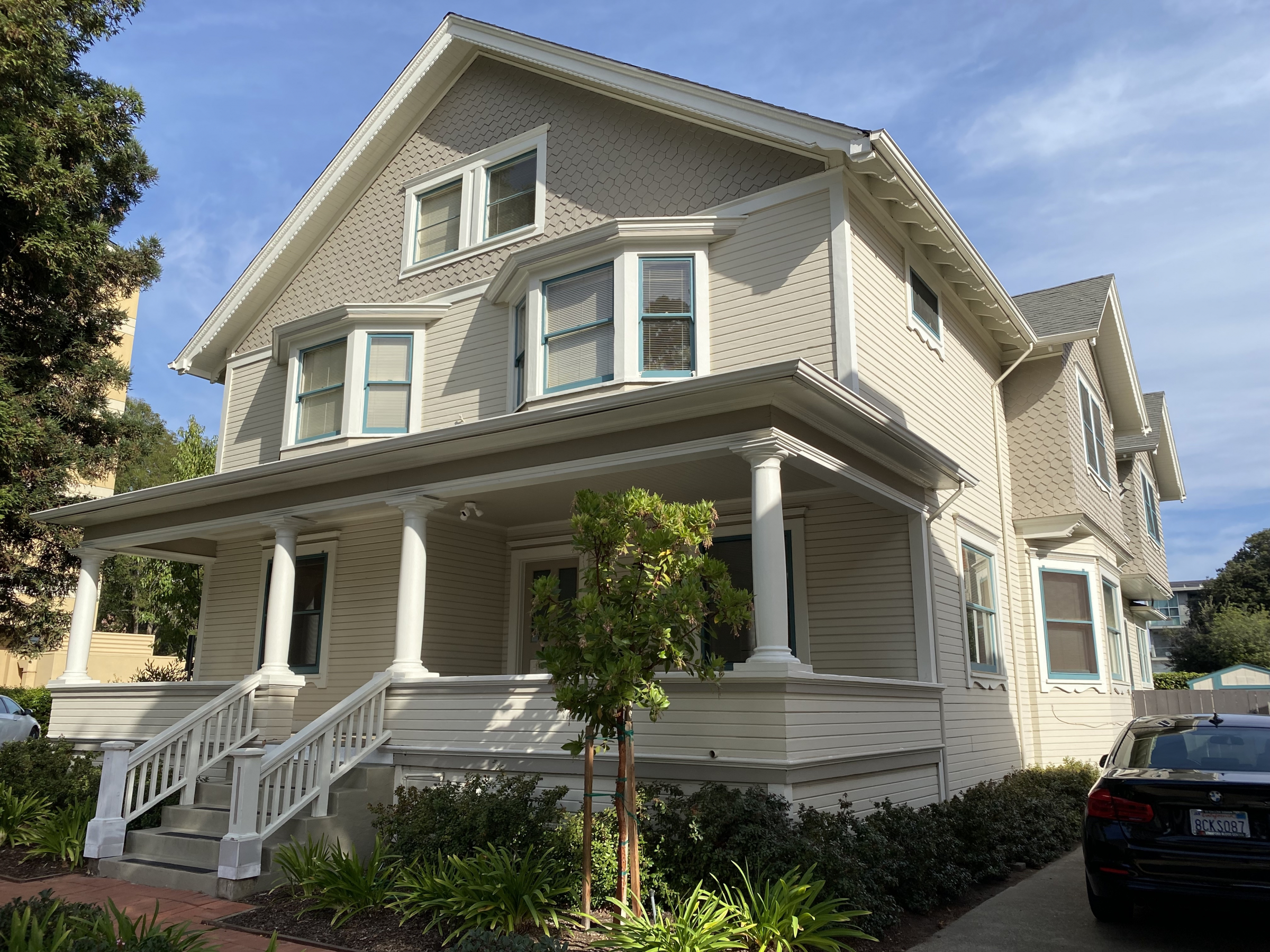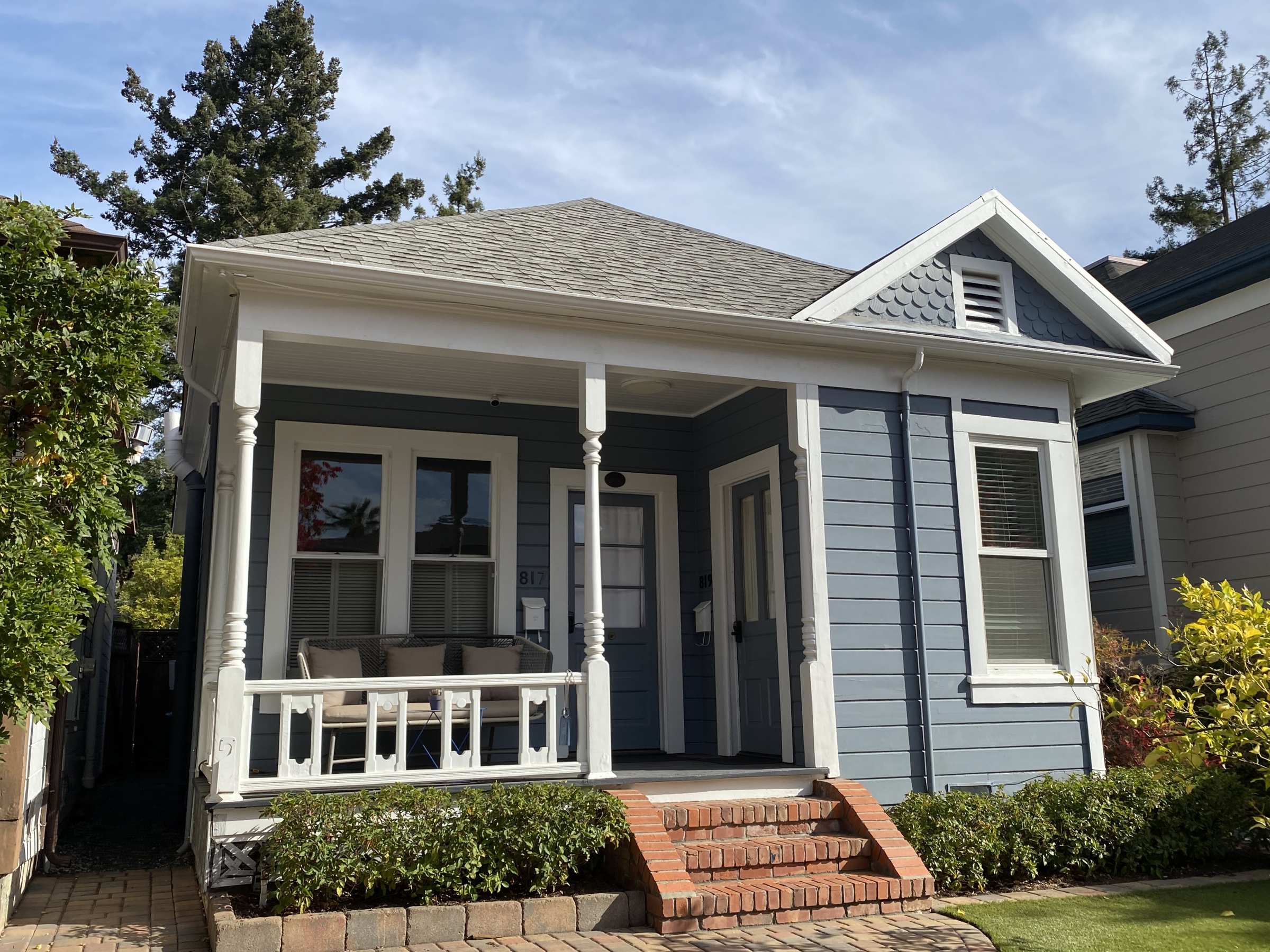When Perry Irvine's law firm was booted from its University Avenue office by its landlord in 1987 and moved into an old two-story building at 635 Bryant St., he and his colleagues embraced the historical features of their new workplace, which combines the Colonial Revival and Queen Anne styles.
Irvine said the 1904 building, which is located across the street from City Hall and originally served as a boarding house, was in bad shape. Contractors had to repair the damage from an unfortunate 1950s remodel and replicate the building's original look, he said.
But despite their appreciation for their new work space, they chose not to request that the building be placed on the city's Historic Registry, a move that could complicate future plans for renovation, he said. On Thursday morning, Nov. 9, Irvine made it clear that, although he has no plans to modify the building, this position hasn't changed.
"We intend to keep it just the way it is," Irvine told the Historic Resources Board at the Nov. 9 hearing.
His comments came as the board was considering whether to place 635 Bryant St. and 67 other properties throughout Palo Alto (but mostly in the northern half) on the local Historic Inventory. This group of properties was the first — and largest — of three batches that the board was set to consider over three separate public hearings before the issue goes to the City Council.
Most of them had already been deemed eligible for a listing on the California Historical Registry by a prior survey completed in 2001. Now, the board is tasked with determining whether to recommend that the property be listed on the local inventory.
For about half of the properties, the answer was an easy "yes." During its Nov. 9 hearing, the board took a series of unanimous votes, approving each subcategory of homes on the proposed list (the 15 subcategories were based on criteria that consultants had used to deem the buildings eligible for the listing).
For the other half, the decision is more complicated. The city received objections from about 30 property owners, and rather than debating the merits of each protest, it scheduled a separate meeting for Jan. 25 to consider these properties. The board will also hold hearings on Dec. 14 and Jan. 11 to consider 66 additional properties for historical designation, as originally planned.
Much like in prior discussions of the topic, the board heard from numerous property owners who took issue with the city's process. Many insisted that the city only move ahead with historical designations if the property owners approve of the change.
Currently, there is no local requirement for homeowner approval. That's in contrast to the California historical register, which does not list properties over objections of property owners.
Chief Planning Official Amy French suggested that Palo Alto may ultimately follow California's example. The state protocol, she said, may be "the example path" that staff will take to the council when it takes up the topic in spring 2024.
If that happens, every property owner will effectively have a veto over proposals by the city – or by another property owner – to place their property on the local registry.
Various speakers made it clear Thursday that they would like the power to say no. Maureen Bard, who lives on Waverley Street, was one of several speakers who criticized Palo Alto's new effort. She lamented the fact that her home is one of just two on the block that were placed on the list, notwithstanding the fact that many other buildings went up more than a century ago.
"No one feels very good about being volunteered to be on this list and being forced to be on it," said Bard, whose home is among those whose fate will be decided on Jan. 25.
"I treasure historical homes, but I don't think it's fair for the city to expect a selected number of us to bear the financial and regulatory burden of maintaining the city's heritage without our consent."
Darlene Yaplee, who also lives on Waverley, urged the city to give homeowners the choice of whether they want their properties listed. The listing, she argued, could impact property values. She submitted a letter from real estate agent Michael Dreyfus, a broker associate at The Dreyfus Group who lived in the historic Professorville district.
In his letter to the council and the board, Dreyfus argued that a historical classification can reduce a property's value by 10% to 20% because it curbs the rights that come with the property.
He cited an example of a home he had recently sold in the Old Palo Alto area, where the land alone was worth $5.5 million but which sold for $4.5 million due to historic restrictions, he wrote.
"Local realtors would unanimously prefer to lift the historic designation if possible," Dreyfus wrote. "While it's arguable that such a status preserves a property's existing condition, it must be acknowledged that this preservation comes at a considerable financial cost to the owner."
Board members have been skeptical about claims that a historical designation brings down property values. Board member Carolyn Willis noted at a prior hearing that many wealthy individuals choose to live in historically recognized buildings.
For Willis, the subject literally hits close to home. Her home was one of the 68 insisted on the Nov. 9 list. When she recused herself by stepping out of the room, the rest of the board unanimously recommended its inclusion on the local inventory.
Willis acknowledged that most of the residents at the hearing came because they don't like what the city is doing. She took heart, however, from the fact that most speakers spoke in very positive terms about their historic homes.
"It's really lovely to hear that most of you, maybe everybody, mentioned how much they enjoyed their historic property, and that's very good for us to hear," Willis said.




Comments
Registered user
Adobe-Meadow
on Nov 9, 2023 at 3:24 pm
Registered user
on Nov 9, 2023 at 3:24 pm
Yeah, allow homeowners to opt in or out. Palo Alto already has too many regulations that increase delays and costs combined with a slow, unresponsive planning dept..
Registered user
Duveneck/St. Francis
on Nov 10, 2023 at 10:35 am
Registered user
on Nov 10, 2023 at 10:35 am
If the city is going to slap the “historical” tag on houses, to elevate the city at the expense of the homeowner, then it seems only fair that the homeowner should be adequately compensated for this. Let it be a *choice* of the homeowner (after all, you’re reducing a homeowner’s usage of the property). If you compensate adequately, people will seek this designation. If they still don’t want it, well, then there’s your answer — it’s not worth it.
This doesn’t need to be an ongoing payment. A onetime payment is sufficient. Future homeowners will know what they’re getting into, and will pay accordingly.
Problem solved.
Registered user
Crescent Park
on Nov 10, 2023 at 10:38 am
Registered user
on Nov 10, 2023 at 10:38 am
I keep waiting for someone to tell me what the legal basis is for an outside consultant to impose historical status on my property without my consent.
Registered user
Embarcadero Oaks/Leland
on Nov 10, 2023 at 11:29 am
Registered user
on Nov 10, 2023 at 11:29 am
I keep waiting to know how much money was wasted on an outside consultant that created a list of properties that's both unnecessary and totally arbitrary since they left out so many oif the older homes.
This whole mess should never have happened! Doesn't the city have better things to do with our money -- like finally opening the libraries
What a waste of time, money and aggravation. The city owes us an explanation for their latest debacle.
Registered user
Old Palo Alto
on Nov 10, 2023 at 1:05 pm
Registered user
on Nov 10, 2023 at 1:05 pm
This is madness. The stated goal (at a City Council meeting a year or two ago) of this unilateral designation was to block homeowners from using Prop 9 to subdivide or add a second home to their lots. However, that has not happened, as is clear from looking at all of the homes on this list. Apparently, due to extensive qualification requirements, Prop 9 has been used hardly at all (if at all) in Palo Alto since it passed. So, this entire process was based on chasing a wholly irrelevant goal.
Additionally, two homes highlighted by this article make clear how arbitrary and nonsensical the results of the expensive survey were. 635 Bryant is a beautiful historic RESIDENCE that was converted to an OFFICE, and now the City wants to preserve its office use and not allow this beautiful HOME to be used as a home anymore? How does that make sense? (Or do they want to convert it back to residential? That is not stated in the article.) And, 817 Kipling is a duplex that has been languishing on the for-sale market for months, possibly because its floor plans (two tiny one-bedroom units with inconveniently placed bedrooms/bathrooms) appeals to very few buyers. It lacks a garage and could benefit from a new owner who wanted to invest in making the units larger and more universally appealling. What possible good is preserving a home in a form that is not livable to potential buyers?
There are so many things that the City could do to actually move the needle when it comes to housing. To me the lowest hanging fruit is follow other city's leads in finally enforcing against the many international (and local) homeowners who continue to leave their homes vacant. A vacancy tax or vacancy fine would incentivize owners of ghost houses finally to put them up for rent or sell them, which could materially increase inventory without any new development! That is great for neighborhoods, communities, and the environment. So many other cities have successful vacancy fees - why not us?
Registered user
Old Palo Alto
on Nov 11, 2023 at 4:18 pm
Registered user
on Nov 11, 2023 at 4:18 pm
I'd be happy to have my home listed as historic. It was built in 1928 and has not been radically changed since it was built. It has been in my family since 1950. We maintain it but try not to alter its classic charm.